A) $4
B) $8
C) $12
D) $20
F) All of the above
Correct Answer

verified
Correct Answer
verified
Short Answer
A field experiment conducted by economists in the Chinese province of Hunan provided evidence that,for poor households in that province,rice is a __________ good.
Correct Answer

verified
Correct Answer
verified
Multiple Choice
Irene is a vegetarian,so she does not eat pork.That is,pork provides no additional utility to Irene.She loves broccoli,however.If we illustrate Irene's indifference curves by drawing broccoli on the horizontal axis and pork on the vertical axis,her indifference curves will
A) slope downward.
B) be vertical straight lines.
C) slope upward.
D) be horizontal straight lines.
F) A) and D)
Correct Answer

verified
Correct Answer
verified
Multiple Choice
Figure 21-25
The figure below illustrates the preferences for a representative consumer,Christopher. 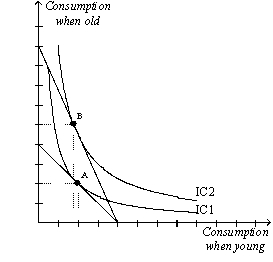 -Refer to Figure 21-25.Interest rates increase by 3 percent.Christopher's optimal choice point moves from A to B.Christopher consumes
-Refer to Figure 21-25.Interest rates increase by 3 percent.Christopher's optimal choice point moves from A to B.Christopher consumes
A) less while he is younger and saves more than he did before interest rates increased.
B) more while he is younger and saves more than he did before interest rates increased.
C) less while he is younger and saves less than he did before interest rates increased.
D) more while he is younger and saves less than he did before interest rates increased.
F) A) and B)
Correct Answer

verified
Correct Answer
verified
Multiple Choice
Mariah spends her income on rice and beans.At her optimum,Mariah's
A) utility from consuming rice is equal to her utility from consuming beams.
B) marginal utility of rice is equal to her marginal utility of beans.
C) marginal utility per dollar spent on rice equals her marginal utility per dollar spent on beans.
D) marginal rate of substitution is equal to 1.
F) A) and C)
Correct Answer

verified
Correct Answer
verified
Multiple Choice
Figure 21-18 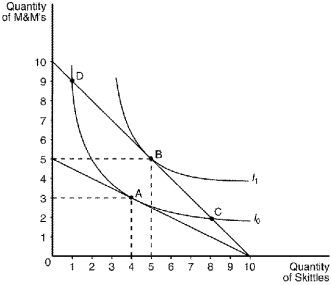 -Refer to Figure 21-18.Assume that the consumer depicted in the figure has an income of $20.The price of Skittles is $2 and the price of M&M's is $4.The consumer's optimal choice is point
-Refer to Figure 21-18.Assume that the consumer depicted in the figure has an income of $20.The price of Skittles is $2 and the price of M&M's is $4.The consumer's optimal choice is point
A) A.
B) B.
C) C.
D) D.
F) None of the above
Correct Answer

verified
Correct Answer
verified
Multiple Choice
Figure 21-20 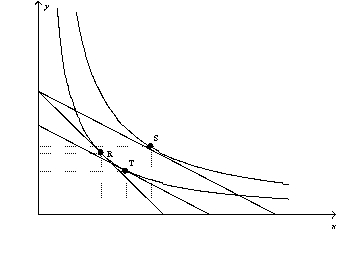 -Refer to Figure 21-20.Suppose that a consumer is originally at point R.Then the price of good X decreases.Which of the following represents the income effect of the price decrease?
-Refer to Figure 21-20.Suppose that a consumer is originally at point R.Then the price of good X decreases.Which of the following represents the income effect of the price decrease?
A) the movement from point R to point S
B) the movement from point R to point T
C) the movement from point T to point S
D) None of the above is correct.
F) None of the above
Correct Answer

verified
Correct Answer
verified
Multiple Choice
Figure 21-18  -Refer to Figure 21-18.Assume that the consumer depicted in the figure has an income of $20.The price of Skittles is $2 and the price of M&M's is $2.The consumer's optimal choice is point
-Refer to Figure 21-18.Assume that the consumer depicted in the figure has an income of $20.The price of Skittles is $2 and the price of M&M's is $2.The consumer's optimal choice is point
A) A.
B) B.
C) C.
D) D.
F) None of the above
Correct Answer

verified
Correct Answer
verified
Multiple Choice
A consumer consumes two normal goods,popcorn and Pepsi.The price of Pepsi rises.The substitution effect,by itself,suggests that the consumer will consume
A) more popcorn and more Pepsi.
B) less popcorn and less Pepsi.
C) more popcorn and less Pepsi.
D) less popcorn and more Pepsi.
F) C) and D)
Correct Answer

verified
Correct Answer
verified
Multiple Choice
Indifference curves graphically represent
A) an income level sufficient to allow an individual to achieve a given level of satisfaction.
B) the constraints faced by individuals.
C) an individual's preferences.
D) the relative price of commodities.
F) C) and D)
Correct Answer

verified
Correct Answer
verified
Multiple Choice
Figure 21-16 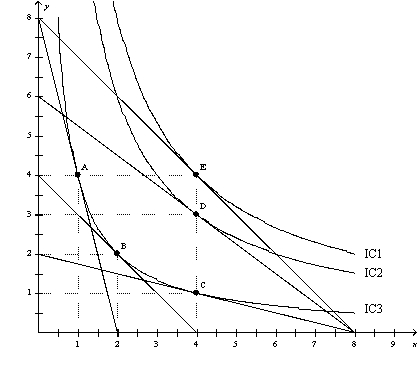 -Refer to Figure 21-16.When the price of X is $6,the price of Y is $24,and income is $48,Steve's optimal choice is point C.Then the price of Y decreases to $8.Steve's new optimal choice is point
-Refer to Figure 21-16.When the price of X is $6,the price of Y is $24,and income is $48,Steve's optimal choice is point C.Then the price of Y decreases to $8.Steve's new optimal choice is point
A) A.
B) B.
C) D.
D) E.
F) A) and C)
Correct Answer

verified
Correct Answer
verified
True/False
The theory of consumer choice illustrates that people face tradeoffs,which is one of the Ten Principles of Economics.
B) False
Correct Answer

verified
Correct Answer
verified
Multiple Choice
If we observe that Jamie's budget constraint has moved outward,then we know for certain that
A) her income must have increased.
B) she will be indifferent between goods X and Y.
C) the price of one or both of the goods must have decreased.
D) she can reach a higher indifference curve.
F) A) and B)
Correct Answer

verified
Correct Answer
verified
Multiple Choice
An optimizing consumer will select the consumption bundle in which the marginal rate of substitution
A) is equal to the price of the least-expensive good.
B) exceeds the marginal utility of each good by the greatest amount.
C) is less than the slope of the budget constraint.
D) None of the above is correct.
F) A) and C)
Correct Answer

verified
Correct Answer
verified
Multiple Choice
An individual's demand curve for a good is derived by varying the
A) income level and observing the resulting total utility derived from both goods.
B) price of one good and observing the resulting quantities of the other good.
C) budget line to the left and calculating the loss in total utility.
D) price of one good and observing the resulting quantities demanded of that good.
F) C) and D)
Correct Answer

verified
Correct Answer
verified
True/False
A rise in the interest rate will generally result in people consuming more when they are old if the substitution effect outweighs the income effect.
B) False
Correct Answer

verified
Correct Answer
verified
True/False
For a typical consumer,most indifference curves are downward sloping.
B) False
Correct Answer

verified
Correct Answer
verified
Multiple Choice
A consumer's preferences provide a ranking of
A) all possible consumption bundles.
B) only the consumption bundles that fall on the same indifference curve.
C) consumption bundles based their prices.
D) consumption bundles based on the consumer's income.
F) A) and B)
Correct Answer

verified
Correct Answer
verified
True/False
The theory of consumer choice is representative of how consumers make decisions but is not intended to be a literal account of the process.
B) False
Correct Answer

verified
Correct Answer
verified
Multiple Choice
Figure 21-10 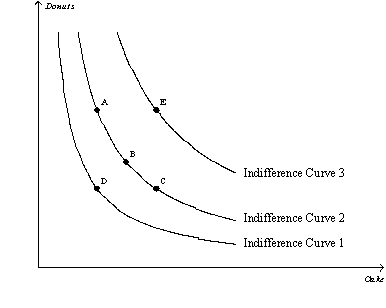 -Refer to Figure 21-10.Which of the following statements is not correct?
-Refer to Figure 21-10.Which of the following statements is not correct?
A) Bundles on Indifference Curve 3 are preferred to bundles on Indifference Curve 1.
B) The consumer is indifferent between bundles A and E because they contain the same number of donuts.
C) The consumer is indifference between bundles B and C.
D) The consumer prefers bundle C to bundle D.
F) A) and C)
Correct Answer

verified
Correct Answer
verified
Showing 201 - 220 of 492
Related Exams